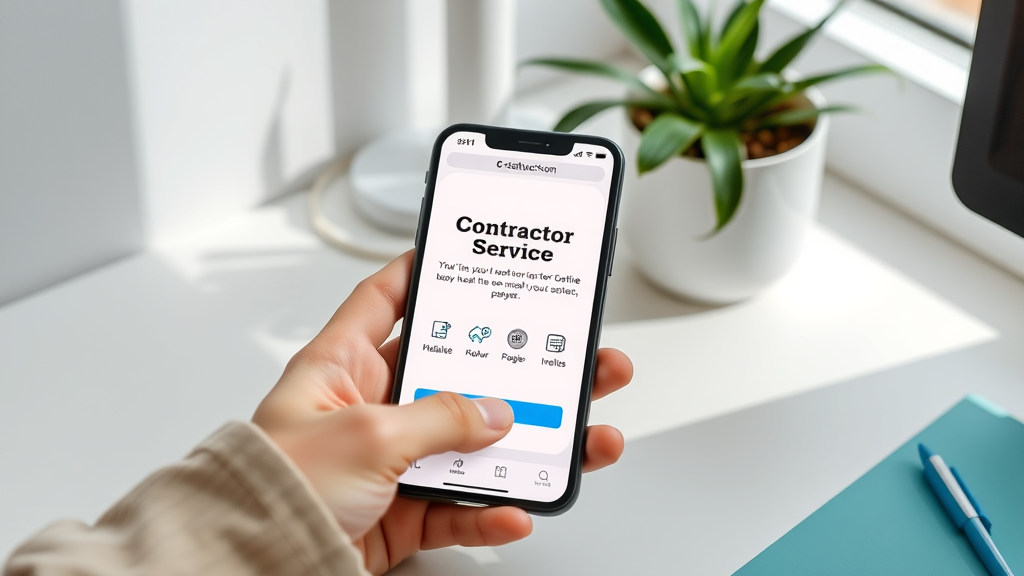Is your contractor business attracting plenty of visitors—but few leads? Discover how the right landing page design can turn wasted traffic into high-value clients, effortlessly.
Are You Wasting Contractor Traffic? How Mastering Landing Page Design Changes the Game
Many contractors pour time and money into driving traffic, but what happens when visitors arrive? If your landing page design isn’t laser-focused on conversions, you’re not just leaving opportunities on the table—you’re practically handing them over to your competitors. Unlike general web page designs, contractor landing pages must guide users from curiosity to commitment in seconds. Aligning every element of your web page with a clear marketing campaign goal—whether scheduling a quote, downloading a resource, or booking a consultation—is how true conversion breakthroughs happen. In this article, you’ll discover actionable strategies and proven design patterns that can elevate your contractor landing page from overlooked to irresistible. Start putting every click to work, and see just how dramatically your pipeline fills when your landing pages are designed not just to look good, but to drive real results.
By leveraging the power of an optimized landing page, contractors can harness web traffic from sources like paid ads, email marketing, and social media posts, and funnel it directly into actionable leads. This approach to landing page design is about more than looks—it’s about performance. Read on for a comprehensive guide to mastering landing pages for contractors, including tool comparisons, best practices, and tested patterns that actually work.

What You’ll Learn About Contractor Landing Page Design Strategies
- Core landing page design principles driving conversions for contractors
- How superior landing page builder tools simplify an effective web page launch
- Ways to create a landing experience tailored for your marketing campaign goals
- Quick comparisons: landing page template versus custom page design for contractors
- Effective call to action placement using proven design patterns
- Essential must-have elements on every converting landing page
- Tips to optimize your web pages for mobile users and lead capture
The Foundation of Landing Page Design for Contractors
What Makes Landing Page Design for Contractors Unique?
Landing page design for contractors stands apart for its single-minded focus: driving high-value leads with minimal distractions. Unlike web pages built for information or branding, contractor landing pages are tightly connected to one marketing campaign at a time—be it a seasonal promotion or a targeted service. By leveraging specialized landing page builder tools, contractors can create landing pages that showcase their best work, highlight stellar testimonials, and include compelling call to action buttons—all in a frictionless, user-friendly layout.
The strongest contractor landing pages ditch clutter and unnecessary navigation, putting clarity and conversion first. Whether using a landing page template or custom page designs, integrating features like mobile-friendly forms, trust badges, and fast load times is essential. When web design and conversion strategy work together, every contractor page becomes an engine for acquiring new clients.

Single-Focus Landing Page: Aligning Web Page Design with One Marketing Campaign
The most successful contractor landing pages don’t try to do everything—they have a single focus and one clear objective. Maybe you want visitors to request an estimate, download a project guide, or sign up for a seasonal deal. Each web page is meticulously crafted to support only that goal, guiding the user naturally from headline to call to action without distraction. By using concise copy, eye-catching visuals, and a strong call to action, these converting landing pages transform passive visitors into motivated prospects.
When you align landing page design with one marketing campaign at a time, your messaging, visuals, and offer reinforce each other. This clarity simplifies decision-making for your visitors and boosts the odds of them taking action—making it a proven strategy for contractors aiming for more leads.
"A landing page isn’t a brochure—it’s a conversion tool. Focus beats features every time."
Essential Elements of High-Converting Landing Page Design
High-converting contractor landing pages all share the same DNA: clear value, trust-building elements, and compelling calls to action. Key features include a powerful headline, relevant imagery that speaks to your target audience, bulletproof testimonials, and easy lead capture forms. If your landing page lacks these building blocks, even the most attractive design skills or page builder tools won’t save your conversion rate.
To create landing pages that consistently perform, integrate trust signals such as accreditations, client logos, and verified reviews. Design mobile-optimized web pages with fast load times, simplified forms, and minimal navigation—the goal is to capture a lead before distractions strike. The best practices in landing page design put user experience and conversion first, every time.

7 Proven Landing Page Design Patterns for Contractors
- The Hero Image with Direct Call to Action
- The Testimonial-Focused Landing Page
- The Before-After-Bridge Pattern in Landing Pages
- The Minimalist Lead Capture Page Design
- The Social Proof Landing Page
- The Offer-Focused Landing Page Template
- The Video-First Landing Page
Pattern 1: Hero Image with Direct Call to Action
A striking hero image paired with a concise headline and bold call to action forms the foundation of many successful landing page designs for contractors. This pattern places the most important information “above the fold,” instantly grabbing attention and encouraging immediate action. The hero image—typically showcasing a completed project, happy client, or your team at work—serves as instant proof of quality. Paired with a prominent CTA button like “Book Free Estimate” or “See Our Work,” this approach simplifies the user journey and significantly boosts conversions. Smart web design choices such as contrasting colors and ample white space ensure that your offer and call to action are the natural focal points.
When using a landing page builder, look for page templates designed with this strategy in mind. The right template or custom web page will let you swap out images, edit copy, and quickly launch high-impact campaigns, giving every page a stunning, professional look that drives results.
Pattern 2: Testimonial Landing Pages and Trust Building
Building trust is everything in contractor marketing, and nothing does it better than authentic testimonials. This pattern dedicates substantial page real estate to real client stories, before-and-after galleries, and ratings from satisfied customers. Testimonials are ideally paired with photos or project snapshots to add authenticity. An effective landing page design might open with a strong testimonial headline (e.g., “Why Homeowners Trust Us”) followed by quick quotes and a carousel of five-star reviews. Every call to action is reinforced by the social proof shown above it—making it easier for prospects to take the leap.
Whether you use a custom design or a landing page template focused on reviews, prioritize web page layouts that allow seamless integration of quotes and imagery. Effective testimonial landing pages keep visual distractions minimal, letting the client’s voice shine.

Pattern 3: Before-After-Bridge Framework for Landing Page Design
The classic before-after-bridge landing page pattern guides visitors through a visual and emotional journey: it highlights the client’s problem (before), celebrates the solution your service delivers (after), and bridges the gap with a clear offer or next step. For contractors, this might mean starting the page with a photo of a dated, damaged room and following with a visually striking “after” shot—a transformation that speaks for itself. Copy connects the dots, showcasing your unique approach and proven process.
A strong call to action at the end of this journey asks visitors to take the next step, emphasizing how easy their own transformation can be. This framework leverages the principles of storytelling in landing page design, making the outcome desirable and attainable.
Pattern 4: Spurring Action with Minimalist Converting Landing Page Designs
Sometimes, less is more. Minimalist contractor landing pages succeed by eliminating clutter, keeping visual and textual distractions to a minimum. These pages use lots of white space, clear headlines, and a direct-to-form approach to guide users straight to the call to action. Every design element must earn its place—if it doesn’t help the user convert, it’s out. For contractors with highly specific offers or time-sensitive promotions, this approach ensures focused, high-quality leads.
Modern page builders offer landing page templates tailored to minimalist designs, so you can create a landing page quickly without sacrificing effectiveness. Choose simple color palettes and a mobile-friendly, single-column layout for best results.

Pattern 5: Social Proof and Credibility in Landing Page Design
Displaying badges, awards, association memberships, client logos, and project numbers offers instant reassurance to potential clients. Social proof landing pages typically feature a trust strip just below the fold—reminding users that your contractor business is proven, reputable, and trusted by others in their community. When backed by recognizable third-party endorsements, this page design bolsters your credibility and may even increase your conversion rates up to 30% or more.
A great landing page design here leverages logos, seals, and very concise copy, keeping visuals prominent and text secondary. Consider integrating automated review feeds or client spotlight features to add ongoing credibility and a sense of community engagement.
Pattern 6: Special Offers & Lead Magnets in Landing Pages
Contractors looking to fill their pipeline fast can use special offer or lead magnet landing pages. These converting landing page designs present free downloads, seasonal deals, or limited-time services in exchange for contact details. Every design element —from contrasting buttons to urgency-driven headlines (“Book by June 30th for $100 Off!”)—focuses on spurring immediate action.
When building this type of web page, choose a landing page template that spotlights your offer, keeps the form short, and reiterates benefits through microcopy or icons. Add clear call to action prompts and reinforce with secondary trust signals to mitigate hesitation.
Pattern 7: Engaging Video as the Centerpiece of Your Landing Page
Video-first landing pages have exploded in popularity for their ability to quickly showcase expertise, personality, and the breadth of finished contractor projects. By embedding a short, professionally produced video “above the fold,” you build instant engagement. The rest of the contractor landing page supports the video’s message with concise text, trust badges, and a single standout call to action.
This landing page design pattern works exceptionally well for web pages promoted via paid ads or social media posts. Video content reduces bounce by keeping visitors’ attention and provides a human touch that static text can’t match.
Choosing the Right Landing Page Builder and Templates for Contractor Sites
Top Features to Look for in a Landing Page Builder
Not all landing page builder tools are created equal. When shopping for your next platform, check for drag-and-drop ease, pre-built landing page templates for contractors, mobile responsiveness, A/B testing, robust integration options (for CRM and email marketing), and analytics dashboards. The best builder will let you create landing pages that look stunning—and convert—without needing advanced web design skills. Look for tools that allow instant previews, reusable components, and real-time editing so you can iterate fast and launch web pages that are always optimized.
If your marketing campaign calls for more customization, ensure the builder also offers ample flexibility for quick edits, custom coding, and the ability to import brand assets. Modern landing page builders have hundreds of components to choose from, ensuring each web page fits your unique vision.
Custom vs. Landing Page Template: Which Is Better for Contractors?
Should you invest in a fully custom landing page design, or leverage a proven landing page template? For many contractors, templates offer a faster, more affordable launch with reliable conversion-focused layouts. Templates accelerate web page creation and provide built-in best practices for lead capture, CTAs, and trust elements.
Custom pages allow greater design flexibility and unique branding, but require more upfront investment and development time. If your contractor marketing campaign has niche requirements or needs to perfectly match your brand identity, a custom build may be worth it. For most use cases—especially when using a reputable landing page builder—templates are not just sufficient, they’re optimal for speed and ROI.
| Tool Name | Customization | Ease of Use | Cost | Integration | Conversion Features |
|---|---|---|---|---|---|
| Unbounce | High | Easy | $$$ | Excellent (CRM, Zapier, Email) | A/B testing, popups, sticky bars |
| Leadpages | Moderate | Very Easy | $$ | Good (Email, Calendar) | Templates, analytics, alert bars |
| Instapage | Very High | Easy | $$$$ | Excellent (Ad platforms, CRM) | Personalization, heatmaps, A/B tests |
| Elementor | High | Easy | $ | Excellent (WP plugins, APIs) | Widgets, mobile editing, templates |
Integrating Landing Pages with Your Marketing Campaign and Social Media

Aligning Landing Page Design with Paid Ads and Email Marketing
For maximum results, every paid ad and email should direct users to a tailored landing page. Don’t recycle the same web page for all campaigns—align each one with the messaging and visuals used in your ad or email. A dedicated landing page ensures the marketing campaign’s promise is fulfilled, the offer is clear, and the next action is obvious. When prospects land on a page designed for their stage in the funnel, bounce rates drop and conversions go up.
Savvy contractors use landing page builder integrations to automate workflows—syncing new leads with their CRM, triggering auto-responders, and personalizing thank you pages. The closer your landing page aligns with your ad creative and email subject lines, the better your campaign ROI.
Optimizing for Social Media Traffic on Contractor Landing Pages
Social media traffic is unpredictable, so top-performing landing pages are simple, fast, and easy to navigate on mobile. When your Facebook, Instagram, or LinkedIn post goes live, make sure the link directs to a web page with minimal distractions and a direct call to action. Use social validation—like recent reviews or “X happy homeowners this month!”—to build trust quickly.
Leverage social proof elements such as share counters or embedded social feeds, but keep sign-up forms short to account for mobile attention spans. When done right, social media campaigns and contractor landing pages work hand-in-hand to turn scrollers into satisfied clients.
Mobile Optimization: Responsive Design and Speed for Modern Landing Pages
The Impact of Mobile-First Landing Page Design on Conversions
More than half of your traffic comes from mobile devices—so your landing page must perform flawlessly on phones and tablets. Responsive landing page designs automatically adjust layout, copy size, imagery, and CTA placement based on device width. To boost conversions, opt for single-column layouts, large tap-friendly buttons, and minimal text entry.
Mobile-optimized landing pages also load faster, which keeps bounce rates low. Whether you use a custom web design or a landing page template, prioritize performance on all devices. Use your landing page builder’s previews and test every launch across popular screen sizes for maximum effect.
Data-Driven Insights: Tracking Success of Your Landing Page Design
Key Landing Page Metrics: Conversion Rate, Bounce Rate, and Session Duration
Tracking the right landing page metrics reveals what’s working and what needs tweaking. Key indicators include conversion rate (what percent of visitors take action), bounce rate (those who leave without engaging), and session duration (how long users stay). The best landing pages have high conversion rates and low bounce, signaling that your web page design, copy, and offers are resonating.
Many top landing page builder platforms include built-in analytics, or can be connected easily to Google Analytics. Analyze these numbers weekly and adjust your campaigns, form fields, offers, or images to keep improving results.
A/B Testing: Optimizing Web Page Elements for Maximum Results
A/B testing is the gold standard for landing page optimization. By running two or more web page versions with subtle changes (different headline, CTA button color, image, or offer), you can scientifically determine which design gets better results. Over time, you build landing pages based on real data, not just guesswork.
Use your landing page builder’s built-in tools, or third-party platforms to split traffic and monitor the metrics mentioned above. Even small tweaks—like moving the call to action higher, or adding another testimonial—can mean significant lifts in leads and booked jobs.
Frequently Asked Questions About Contractor Landing Page Design
-
How do I create a landing page optimized for contractors?
Build with a proven landing page builder or template. Focus on one service or offer per page, use client testimonials, showcase portfolio images, include trust badges, and feature a clear call to action near the top and bottom. Always test on mobile and keep the form short. -
What’s the #1 element that improves landing page conversion rates?
A high-contrast, well-placed call to action—preferably above the fold—has the single biggest impact on conversion rates for contractor landing pages. -
How do call to action placements impact converting landing pages?
Placing CTAs at natural stopping points (top, mid-page, bottom) captures interest as visitors scroll. The more prominent and accessible your call to action, the better your results. -
Are page builders better than custom developer solutions for small contractors?
For speed and cost-efficiency, page builders with contractor-focused templates are ideal for most small businesses. Custom solutions are best if you need unique features or advanced branding. -
Which landing page template style is best for lead generation?
Hero image templates with a clear call to action and quick testimonials consistently deliver the best lead generation results for contractors.
People Also Ask: Landing Page Design for Contractors
What are the key elements of an effective landing page for contractors?
An effective contractor landing page features a compelling headline, engaging images of past projects, strong client testimonials, clear trust signals, and an unmistakable call to action. Keep navigation minimal and lead forms simple for optimal results. Use proven landing page templates to accelerate the creation process and ensure all essential design components are included.
Why is landing page design important for lead generation in contracting?
Landing page design is critical because it transforms passive visits into actionable leads. Focused web page layouts with attention-grabbing offers, trust-building elements, and streamlined forms drive more inquiries, boost appointment bookings, and maximize the ROI of your marketing campaigns. Well-designed landing pages create a seamless journey from interest to conversion.
How do landing page builders streamline the creation process for contractor businesses?
Landing page builder platforms make it easy to drag and drop components, choose from contractor-focused templates, and publish professional pages without coding. They offer real-time previews, mobile optimization, and integrations with email or CRM tools—so contractors can build landing pages fast and update them whenever needed.
What are some common mistakes to avoid in contractor landing page design?
Avoid cluttered layouts, slow-loading images, unclear value propositions, and forms with too many fields. Don’t bury your call to action or overwhelm visitors with too much copy. Always test for mobile responsiveness and review analytics to catch friction points that might be causing bottlenecks in the conversion process.
Best Practices and Key Takeaways for Contractor Landing Page Design
- Focus every landing page design on a single conversion goal
- Prioritize concise messaging and trust signals
- Utilize proven landing page templates to accelerate deployment
- Test and track page performance metrics constantly
- Use landing page builder features to quickly iterate and improve results
Conclusion: Securing More Contractor Leads with Strategic Landing Page Design
"In the contractor world, the difference between a visitor and a booked client is often just a few smart landing page design decisions."
Ready to put your website to work? Book a Free Consultation or text Us 720.892.5968
 Add Row
Add Row  Add
Add 




Write A Comment